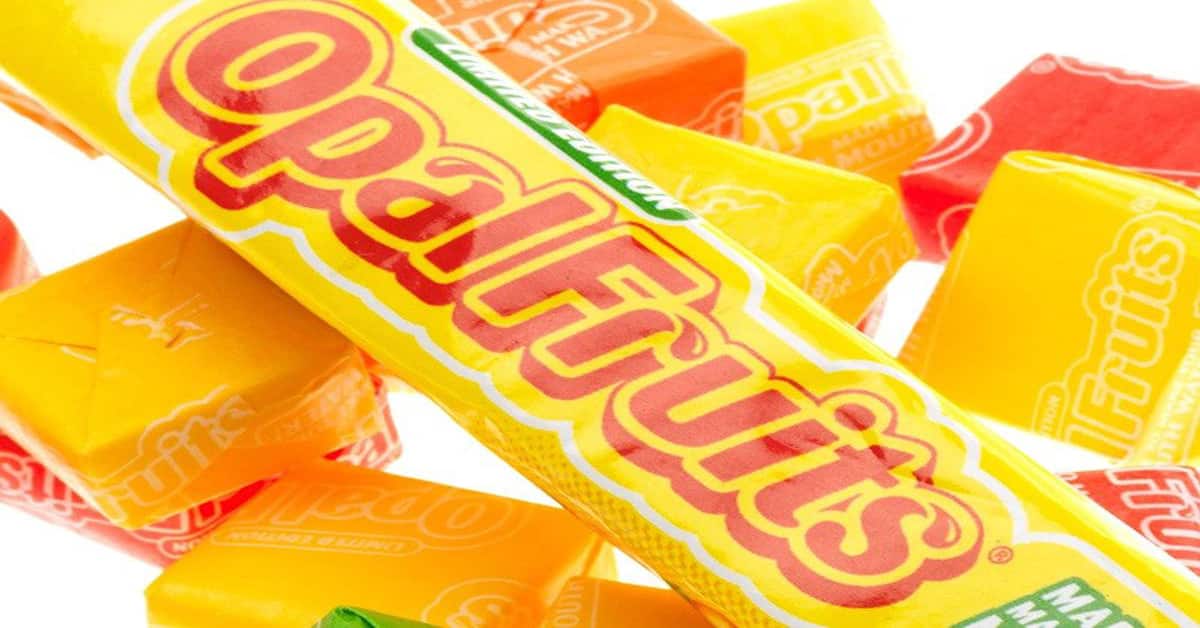Opal Fruits (History, FAQ, Flavors & Commercials)
Many people are not aware that Opal Fruits is the original name for a much more familiar candy, Starburst. Many people also do not know that this candy was originally sold only in the UK under the original Opal Fruits name.
This is one of the most popular candies that is sold today and most people love Starburst. If you had no idea that this candy was originally sold under a different name, you probably have a lot of great memories associated with sharing Starburst candies with your friends and family. If you want to know some more about this well-known candy’s history, you should keep reading!
Please leave a review or any memories of this snack in the comments at the bottom of this page. Thank you!
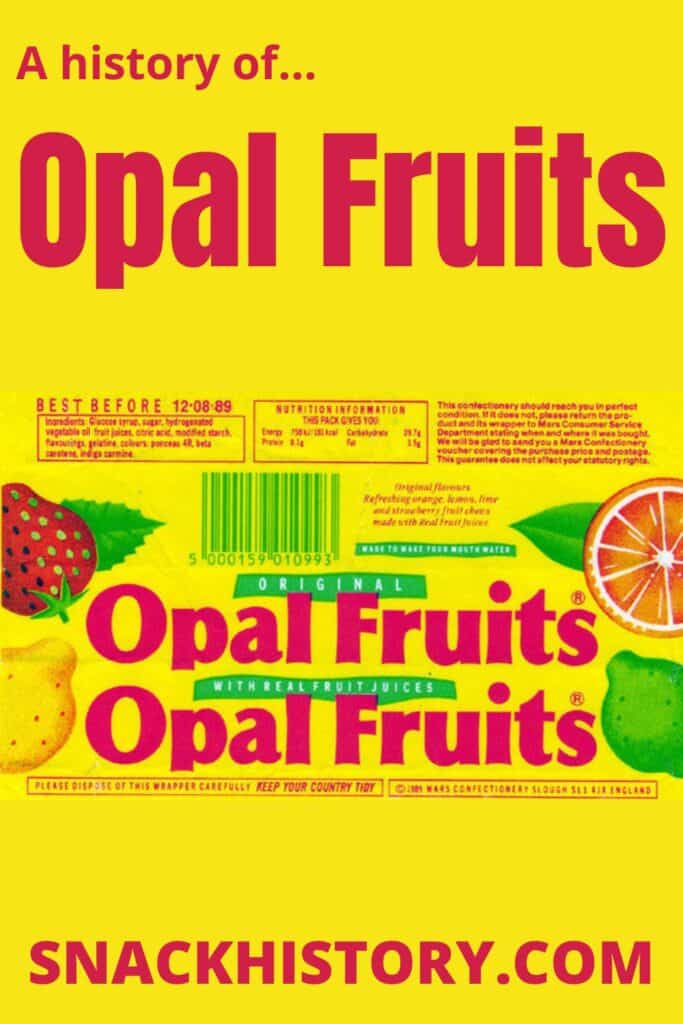
History
Opal Fruits were originally sold in the UK in 1959. The original flavors were blackcurrant, lemon and lime, orange, and strawberry. Today there are many flavors, and varieties of this candy, and the original shape and texture of the candy have not changed much over the years. This has always been a square and soft taffy-like candy that is sold in a variety of wrappers.
The original wrappers were yellow, and the Opal Fruits logo was added in simple red block lettering on each wrapper. The Twenty-One Fruits version of the candy that was sold for a limited time in the UK was encased in the same wrapper. Various well-known retro wrappers have been brought back over the years when the Opal Fruits branding is brought out for a special holiday or to commemorate something.
Mars named Opal Fruits after a contest that was used to name the candy. Peter Phillips who was known as Peter Pfeffer at the time, was the lucky winner who got to name the product. The product was made in Slough in Berkshire, UK at first, well before it was introduced to US markets. The original product was likely made to be an unusual shape and texture partially due to the popular space race candies that were popular at the time. The original Starburst flavors matched the UK ones, but they were changed to more popular ones for the US market over time.
The candy was first sold in the US in 1967. They were sold under the name M&Ms Fruit Chewies. They were not named Starburst until later. The first variant of the candy was actually sold briefly under the name Sunshine Flavors, and Tropical Opal Fruits was another naming convention that was short-lived.
It is thought that the Starburst name was meant to express the burst of flavor that was advertised as being the main takeaway from the experience of eating this candy, but no one has confirmed that this is the reason for the name. The other possibility is that the timing of the change of name was convenient to interest in the Space Race and so the name was meant to evoke a connection to science and space travel.
The Opal Fruits product was advertised as a candy that, “makes your mouth water”. When the original name was changed, advertising was based more on the fun flavors of the candy, and there were ad campaigns linked with marketing for movies like Pirates of the Caribbean. Many of the more modern ads have been blatantly silly, and this helped make a name for the product as a fun and relevant one that all ages can enjoy. The Opal Fruits product was already linked with the concept of real fruit flavor. This has been a continuous part of the advertising of this product from the beginning.
Opal Fruits has a significant fan following, and there are many people who were very unhappy that the product changed and was then renamed. The original candy was a bit softer in the middle with a more gel-like center. There are still people today who claim that taking away the center of the candy as it once was has changed everything about the candy in a negative way.
There are a variety of older candies that people in the UK still wish could be brought back. Opal Fruits are probably at the very top of the list. You will likely never get to experience the original product, but there have been a few times when the original treat has been sold again briefly. These sales are usually confined to the UK market and are brief.
In 1998 Opal Fruits changed its name to Starburst, much to the confusion of the British public. The change was meant to help with brand consistency in the market and to freshen up the image of the brand. When Mars bought Wrigley, they transferred the Starburst product to the Wrigley division. This led to the creation of the ‘Original Fruits” version of the candies.
Starburst are also sold in the US in the form of popsicles, gum, candy corn, jelly beans, fruit roll-ups, gelatin, energy drinks, lip gloss, and even yogurt. There were also some non-taffy products that were sold in Australia and Asia-Pacific countries like New Zealand. Some of these are items like “Snakes” gummies and “Sucks” lollipops. These were also discontinued in 2019 and 2020.
In the US, the slogan for the candies is, “Unexplainably Juicy”. Over the years since the Opal Fruits brand name was retired, it has been brought back from time to time for special edition sales related to deals with other brands or important dates in the history of the candy. Starburst products are not sold in Australia anymore, and no Starburst product has been sold in Australia since 1996.
Many people are most familiar with Starburst as a movie candy, but you can get this candy in most grocery stores and almost every grocery store around the US today. This is one of the most successful products that Mars/Wrigley markets, and it often outsells many of the other traditional candies that they still sell today. If you did not know that Starburst started out as a UK-based candy with a bit of an odd name before becoming the Starburst that you know and love today, now you know a lot more about this very popular candy that nearly everyone loves!
Flavors
The original Opal Fruits flavors were:
- Lemon
- Lime
- Orange
- Strawberry
In the UK, this product is entirely vegan, however, in the US the product is made with non-vegan gelatin. Lime starburst got a comeback in the US as the “Baja” version of the candy. The UK also has a version that is called Starburst Choozers. These are lozenge-shaped and have a soft, gel-like center. They are sold with the tagline, “the chews that ooze”.
There have been various taglines used to market the Opal Fruits and Starburst products in all the various places that they are sold. Many of them are meant to communicate that the product is fruity, chewy, or even fun. You might remember a whole variety of different slogans and advertising taglines for this candy if you have enjoyed it for years.
Starburst in Popular Culture
This is such a familiar product that most people are aware of the primary thing that Starburst are known for in popular culture. Most teenagers teach each other about the trick of unwrapping Starburst without using their hands. This is supposed to be a means to tell if someone is a good kisser, and the teens that are able to get the wrapper off a Starburst hold this skill set as a matter of pride.
Pink is also the most popular of the flavors of this treat, and it outsells the other varieties every year. When voting was done to determine which flavors should be continued and which should be replaced, lemon/lime was the lowest on the list, and pink was the highest. The popular meme that states that you should never let anyone treat you like a yellow Starburst and you should be sure you are treated like a pink Starburst really does seem to carry some real weight with consumers.
The All Pink packaging was created to meet the demand for a pink-only version of the treat, and you can still get All Pink packages of this candy in many places. Just like the FaveRED, this was originally created to be a short-lived project that has instead become a long-term favorite with those who love Starburst.
Logo
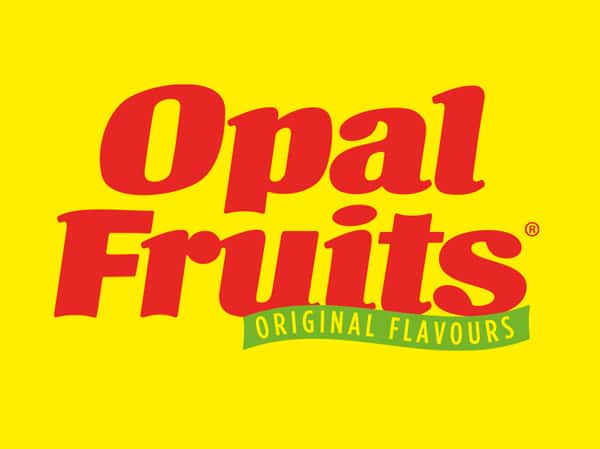
Ingredients
- Glucose Syrup
- Sugar
- Palm Fat
- Concentrated Fruit Juice 1%* (Apple, Orange, Strawberry, Lemon, Lime)
- Acid Citric Acid
- Modified Starch
- Acid Malic Acid
- Dextrin
- Maltodextrin
- Flavorings
- Antioxidant Ascorbic Acid
- Emulsifier Lecithin
- Spirulina Extract
- Colors Anthocyanins
- Beta-Carotene
- Curcumin
- *Equivalent to 5.8% Fruit Juice
Nutrition
| Serving Size: | 1 Single Piece | % Daily Value * |
| Carbs | 3g | |
| Dietary Fiber | –g | |
| Sugar | 2g | |
| Fat | 0g | |
| Saturated | 0g | |
| Polyunsaturated | 0g | |
| Monounsaturated | –g | |
| Trans | –g | |
| Protein | 0g | |
| Sodium | 4mg | |
| Potassium | –mg | |
| Cholesterol | –mg | |
| Vitamin A | –% | |
| Vitamin C | –% | |
| Calcium | –% | |
| Iron | –% |
- Percentages are based on a diet of 2000 calories a day.
Pictures
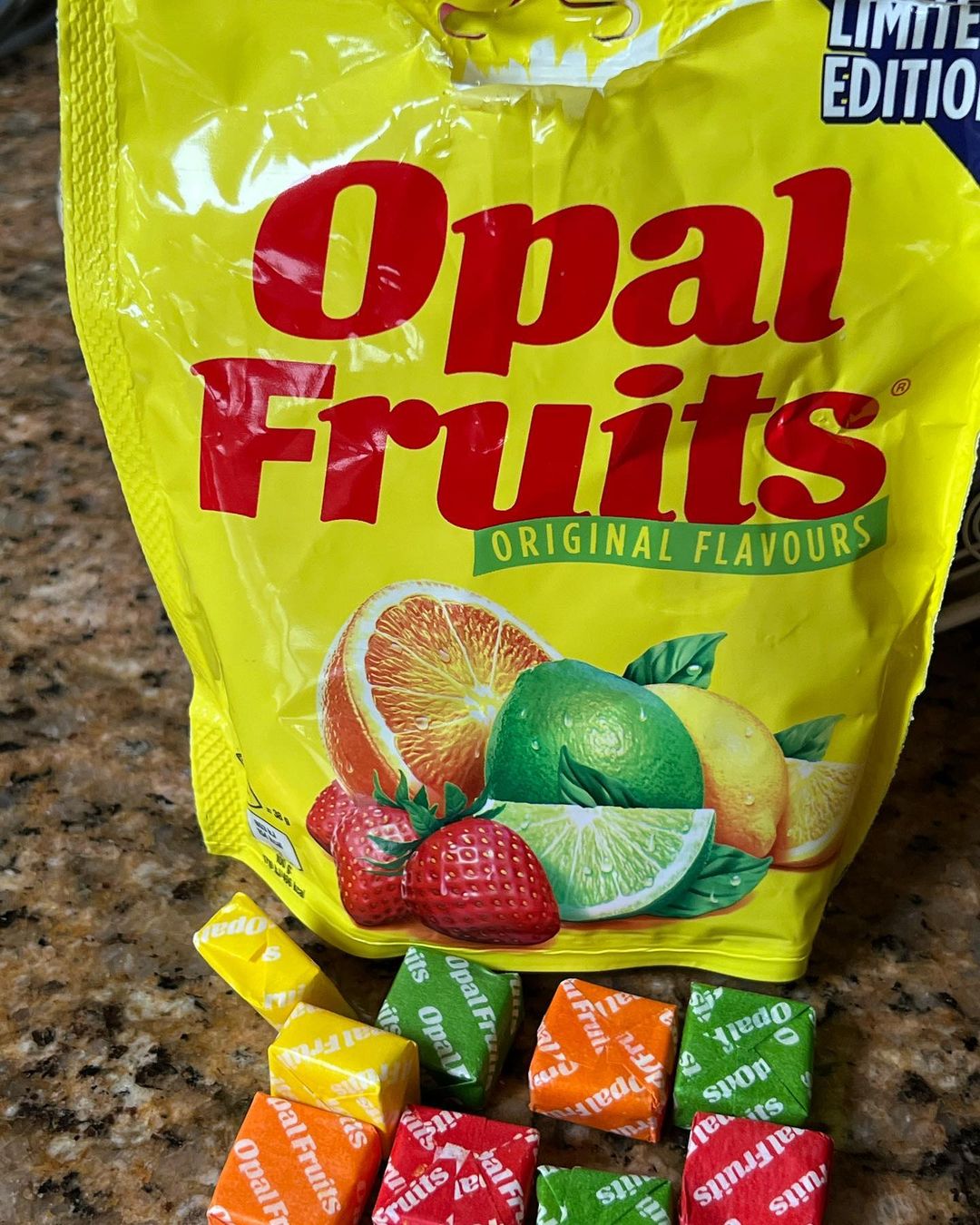
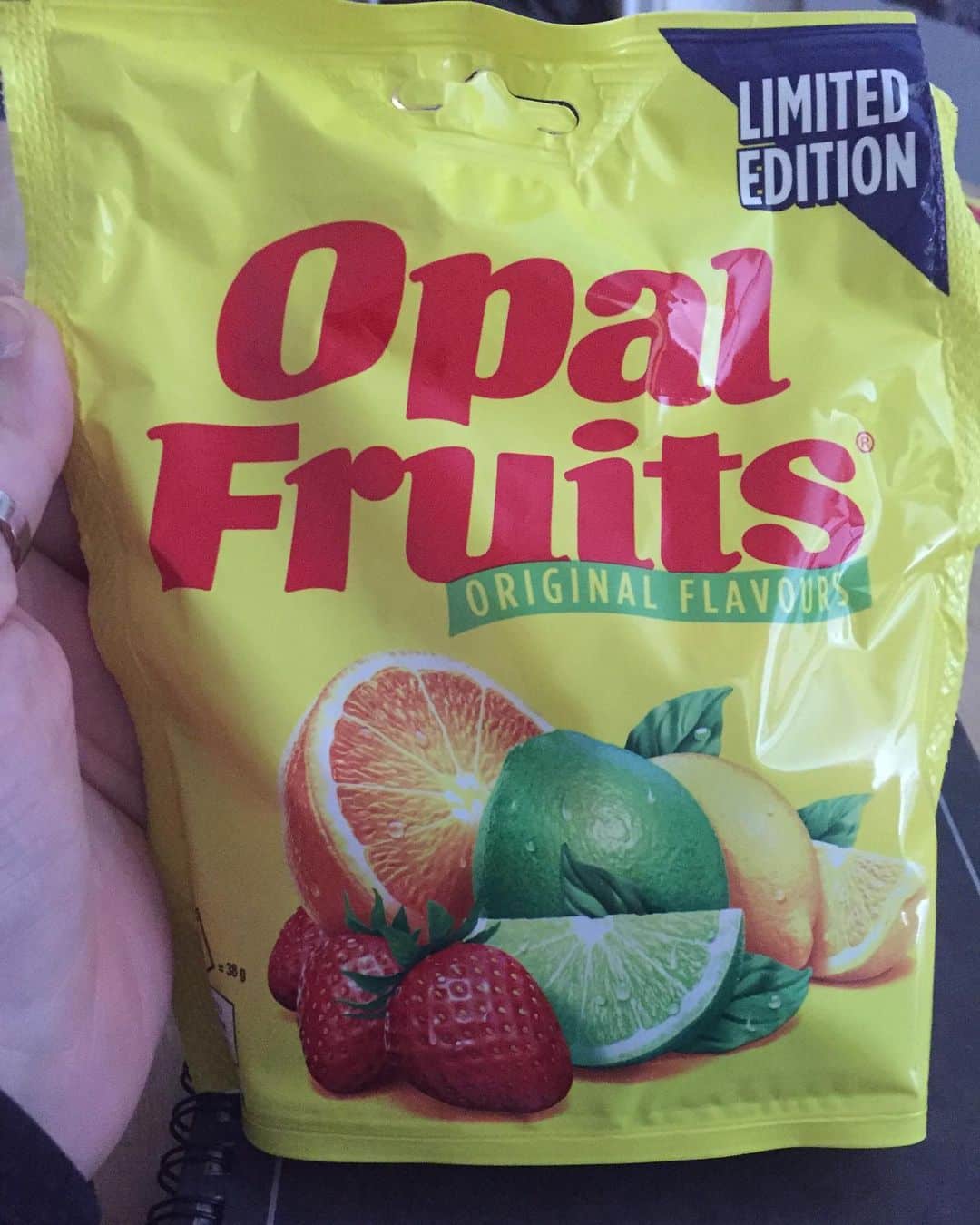
Commercials
FAQ
When did Opal Fruits become Starburst?
Opal Fruits was rebranded to Starburst in 1998 in the UK. It was met by confusion by the British public.
Why did Opal Fruits change to Starburst?
Opal Fruits were rebranded from Opal Fruits to Starburst to match the U.S branding of the popular candy.

My name is Brianna and I love writing on all topics. Candy history fascinates me and I am passionate about sharing my love of this topic with everyone else!
Please leave a review or any memories of this snack in the comments below. Thank you!
Click here for a full A-Z list of Snacks and Candy
